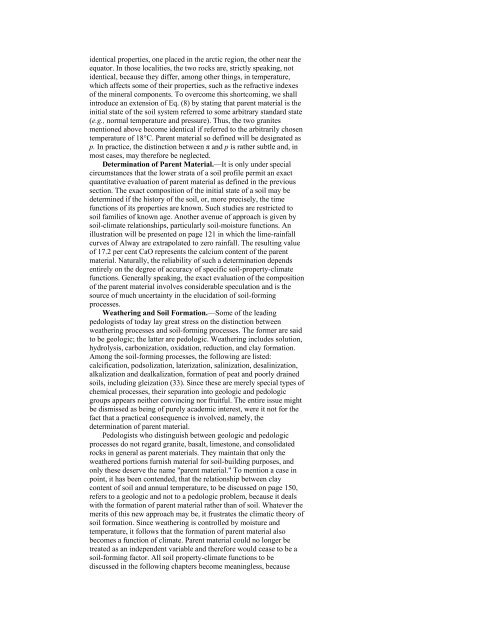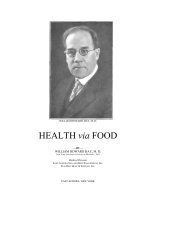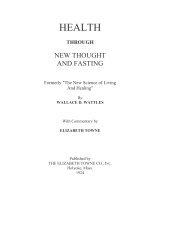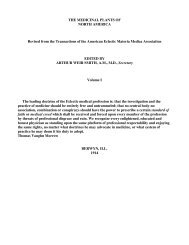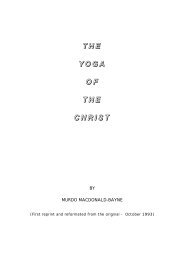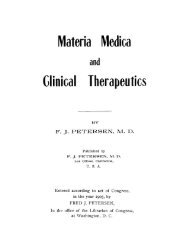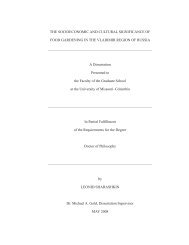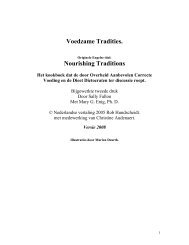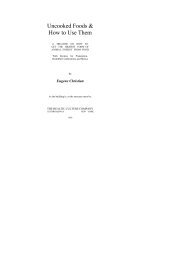FACTORS OF SOIL FORMATION - Midlands State University
FACTORS OF SOIL FORMATION - Midlands State University
FACTORS OF SOIL FORMATION - Midlands State University
You also want an ePaper? Increase the reach of your titles
YUMPU automatically turns print PDFs into web optimized ePapers that Google loves.
identical properties, one placed in the arctic region, the other near the<br />
equator. In those localities, the two rocks are, strictly speaking, not<br />
identical, because they differ, among other things, in temperature,<br />
which affects some of their properties, such as the refractive indexes<br />
of the mineral components. To overcome this shortcoming, we shall<br />
introduce an extension of Eq. (8) by stating that parent material is the<br />
initial state of the soil system referred to some arbitrary standard state<br />
(e.g., normal temperature and pressure). Thus, the two granites<br />
mentioned above become identical if referred to the arbitrarily chosen<br />
temperature of 18°C. Parent material so defined will be designated as<br />
p. In practice, the distinction between π and p is rather subtle and, in<br />
most cases, may therefore be neglected.<br />
Determination of Parent Material.—It is only under special<br />
circumstances that the lower strata of a soil profile permit an exact<br />
quantitative evaluation of parent material as defined in the previous<br />
section. The exact composition of the initial state of a soil may be<br />
determined if the history of the soil, or, more precisely, the time<br />
functions of its properties are known. Such studies are restricted to<br />
soil families of known age. Another avenue of approach is given by<br />
soil-climate relationships, particularly soil-moisture functions. An<br />
illustration will be presented on page 121 in which the lime-rainfall<br />
curves of Alway are extrapolated to zero rainfall. The resulting value<br />
of 17.2 per cent CaO represents the calcium content of the parent<br />
material. Naturally, the reliability of such a determination depends<br />
entirely on the degree of accuracy of specific soil-property-climate<br />
functions. Generally speaking, the exact evaluation of the composition<br />
of the parent material involves considerable speculation and is the<br />
source of much uncertainty in the elucidation of soil-forming<br />
processes.<br />
Weathering and Soil Formation.—Some of the leading<br />
pedologists of today lay great stress on the distinction between<br />
weathering processes and soil-forming processes. The former are said<br />
to be geologic; the latter are pedologic. Weathering includes solution,<br />
hydrolysis, carbonization, oxidation, reduction, and clay formation.<br />
Among the soil-forming processes, the following are listed:<br />
calcification, podsolization, laterization, salinization, desalinization,<br />
alkalization and dealkalization, formation of peat and poorly drained<br />
soils, including gleization (33). Since these are merely special types of<br />
chemical processes, their separation into geologic and pedologic<br />
groups appears neither convincing nor fruitful. The entire issue might<br />
be dismissed as being of purely academic interest, were it not for the<br />
fact that a practical consequence is involved, namely, the<br />
determination of parent material.<br />
Pedologists who distinguish between geologic and pedologic<br />
processes do not regard granite, basalt, limestone, and consolidated<br />
rocks in general as parent materials. They maintain that only the<br />
weathered portions furnish material for soil-building purposes, and<br />
only these deserve the name "parent material." To mention a case in<br />
point, it has been contended, that the relationship between clay<br />
content of soil and annual temperature, to be discussed on page 150,<br />
refers to a geologic and not to a pedologic problem, because it deals<br />
with the formation of parent material rather than of soil. Whatever the<br />
merits of this new approach may be, it frustrates the climatic theory of<br />
soil formation. Since weathering is controlled by moisture and<br />
temperature, it follows that the formation of parent material also<br />
becomes a function of climate. Parent material could no longer be<br />
treated as an independent variable and therefore would cease to be a<br />
soil-forming factor. All soil property-climate functions to be<br />
discussed in the following chapters become meaningless, because


